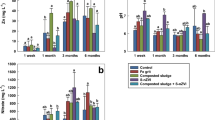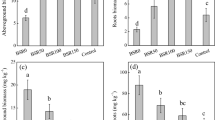Abstract
Purpose
Land utilization of sewage sludge and sludge compost is a common practice in many countries. Soils amended with sewage sludge and sludge compost display different physicochemical properties, especially in terms of dissolved organic matter (DOM) composition that affects the electron-donating capacity (EDC) of DOM in soils. The aim of this paper was to compare the EDC of DOM derived from sewage sludge and sludge compost for enhancing Fe(III) bioreduction. It is expected that this research could be helpful for further understanding of soil remediation in the future.
Materials and methods
Sludge and compost DOM were extracted from sewage sludge and sludge compost, respectively. Fractionation, CHNO/S analysis, Fourier-transform infrared and ultraviolet-visible spectroscopy, and cyclic voltammetry were then used to determine the degree of aromaticity and humification in the samples. To determine if their EDC was altered during composting, samples were reduced by the humic-reducing bacterium, Shewanella cinica D14T, after which their EDC values were determined. The initial and potential EDC values of the samples were measured using FeCl3/Fe(citrate) as an electron acceptor. The insoluble Fe(III) oxide reduction by strain D14T was mediated by DOM.
Results and discussion
Both sludge and compost DOM contained redox-active functional groups that could shuttle electrons to insoluble Fe(III) oxide and accelerate Fe(III) bioreduction. When FeCl3 was used as an oxidizing agent, their potential EDC reached 0.25 and 0.50 meq/(mg C), respectively. In addition, their electron transfer ability could be recycled.
Conclusions
The degree of humification of DOM increased during sludge composting, which resulted in the EDC of compost DOM being greater than that of sludge DOM. Furthermore, the rate of Fe(III) bioreduction mediated by DOM could be accelerated under anaerobic conditions, which has important implications for soil biogeochemistry because it may accelerate the rate of some kinds of toxic metals and recalcitrant organic pollutants transformation or degradation.





Similar content being viewed by others
References
Bauer M, Heitmann T, Macalady D, Blodau C (2007) Electron transfer capacities and reaction kinetics of peat dissolved organic matter. Environ Sci Technol 41:139–145
Blodau C, Bauer M, Regenspurg S, Macalady D (2009) Electron accepting capacity of dissolved organic matter as determined by reaction with metallic zinc. Chem Geol 260:186–195
Brazauskiene D-M, Paulauskas V, Sabiene N (2008) Speciation of Zn, Cu, and Pb in the soil depending on soil texture and fertilization with sewage sludge compost. J Soils Sediments 8:85–92
Burgos WD, Pisutpaisal N, Tuntoolavest M, Chorover J, Unz RF (2000) Biodegradation of 1-naphthol in the presence of humic acid. Environ Eng Sci 17:343–351
Cervantes FJ, de Bok FAM, Tuan DD, Stams AJM, Lettinga G, Field JA (2002) Reduction of humic substances by halorespiring, sulphate-reducing and methanogenic microorganisms. Environ Microbiol 4(1):51–57
Chefetz B, Adani F, Genevini P, Tambone F, Hadar Y, Chen Y (1998) Characterization of dissolved organic matter extracted from composted municipal solid waste. Soil Sci Soc Am J 62:326–332
Chen Z, Xing B, McGill WB, Dudas MJ (1996) Alpha-naphthol sorption as regulated by structural and composition of organic substances in soils and sediments. Can J Soil Sci 76:513–522
Chen J, Baohua Gu, LeBoeuf EJ, Pan H, Dai S (2002) Spectroscopic characterization of the structural and functional properties of natural organic matter fractions. Chemospher 48:59–68
Chin Y-P, Aiken G, O’Loughlin E (1994) Molecular weight, polydispersity, and spectroscopic properties of aquatic humic substances. Environ Sci Technol 28(11):1853–1858
Coates JD, Cole KA, Chakraborty R, O’Connor SM, Achenbach LA (2002) Diversity and ubiquity of bacteria capable of utilizing humic substances as electron donors for anaerobic respiration. Appl Environ Microbiol 68(5):2445–2452
Dunnivant FM, Schwarzenbach RP, Macalady DL (1992) Reduction of substituted nitrobenzenes in aqueous solution containing natural organic matter. Environ Sci Technol 26:2133–2141
Eary LE, Rai D (1988) Chromate removal from aqueous wastes by reduction with ferrous ion. Environ Sci Technol 22:972–977
Fredrickson JK, Zachara JM, Kennedy DW, Dong H, Onstott TC, Hinman NW, Li S-M (1998) Biogenic iron mineralization accompanying the dissimilatory reduction of hydrous ferric oxide by a groundwater bacterium. Geochim Cosmochim Acta 62(19–20):3239–3257
Fredrickson JK, Zachara JM, Kennedy DW, Duff MC, Gorby YA, Li SW, Krupka KM (2000) Reduction of U(VI) in goethite (α-FeOOH) suspensions by a dissimilatory metal-reducing bacterium. Geochim Cosmochim Acta 64(18):3085–3098
Han N, Thompson L (1999) Soluble organic carbon in a biosolids-amended mollisol. J Environ Qual 28:652–658
Heitmann T, Blodau C (2006) Oxidation and incorporation of hydrogen sulfide by dissolved organic matter. Chem Geol 235:12–20
Heitmann T, Goldhammer T, Beer J, Blodau C (2007) Electron transfer of dissolved organic matter and its potential significance for anaerobic respiration in a northern bog. Glob Chang Biol 13:1771–1785
Jiang J, Kappler A (2008) Kinetics of microbial and chemical reduction of humic substances: implications for electron shuttling. Environ Sci Technol 42:3563–3569
Kalbitz K, Solinger S, Park J-H, Michalzik B, Matzner E (2000) Control on the dynamics of dissolved organic matter in soils: a review. Soil Sci 165(4):277–304
Kappler A, Haderlein SB (2003) Natural organic matter as reductant for chlorinated aliphatic pollutants. Environ Sci Technol 37(12):2714–2719
Kappler A, Benz M, Schink B, Brune A (2004) Electron shuttling via humic acids in microbial iron(III) reduction in a freshwater sediment. FEMS Microbiol Ecol 47(1):85–92
Li XM, Zhou SG, Li FB, Wu CY, Zhuang L, Wu W, Liu L (2009) Fe(III) oxide reduction and carbon tetrachloride dechlorinated by a newly isolated Klebsiella pneumoniae strain L17. J Appl Microbial 106:130–139
Litz NT, Müller J, Böhmer W (2007) Occurrence of polycyclic musks in sewage sludge and their behaviour in soils and plants (Part 2: investigation of polycyclic musks in soils and plants). J Soils Sediments 7(1):36–44
Lovley DR (1995) Microbial reduction of iron, manganese, and other metals. Adv Agron 54:175–231
Lovley DR, Coates JD, Blunt-Harris EL, Phillips EJP, Woodward JC (1996a) Humic substances as electron acceptors for microbial respiration. Nature 382:445–448
Lovley DR, Woodward JC, Chapelle FH (1996b) Rapid anaerobic benzene oxidation with a variety of chelated Fe(III) forms. Appl Environ Microbiol 62:288–291
Lovley DR, Kashefi K, Vargas M, Tor JM, Blunt-Harris EL (2000) Reduction of humic substances and Fe(III) by hyperthermophilic microorganisms. Chem Geol 169(3–4):289–298
McGrath SP, Change AC, Page AL, Witter E (1994) Land application of sewage sludge: scientific perspectives of heavy metal loading limits in Europe and the United States. Environ Rev 2:108–118
Nurmi JT, Tratnyek PG (2002) Electrochemical properties of natural organic matter (NOM), fractions of NOM, and model biogeochemical electron shuttles. Environ Sci Technol 36:617–624
Peretyazhko T, Sposito G (2006) Reducing capacity of terrestrial humic acids. Geoderma 137:140–146
Peuravuori J, Pihlaja K (1997) Molecular size distribution and spectroscopic properties of aquatic humic substances. Anal Chim Acta 337(2):133–149
Picardal FW, Arnold RG, Huey BB (1995) Effects of electron donor and acceptor conditions on reductive dehalogenation of tetrachloromethane by Shewanella putrefaciens 200. Appl Environ Microbiol 61:8–12
Scott DT, Mcknight DM, Blunt-Harris EL, Kolesar SE, Lovley DR (1998) Quinone moieties act as electron acceptors in the reduction of humic substances by humics-reducing microorganisms. Environ Sci Technol 32:2984–2989
Selivanovskaya SY, Latypova VZ (2003) The use of bioassays for evaluating the toxicity of sewage sludge and sewage sludge-amended soil. J Soils Sediments 3(2):85–92
Struyk Z, Sposito G (2001) Redox properties of standard humic acids. Geoderma 102:329–346
Wang YB, Wu CY, Wang XJ, Zhou SG (2009) The role of humic substances in the anaerobic reductive dechlorination of 2, 4-dichlorophenoxyacetic acid by Comamonas koreensis strain CY01. J Hazard Mater 164:941–947
Xu W, Hu P, Zhou SG, Li XM, Li YH (2009) Electron shuttling function of dissolved organic matter. Environmental Science 30(8):2297–2301 in Chinese
Zhang HC, Weber EJ (2009) Elucidating the role of electron shuttles in reductive transformations in anaerobic sediments. Environ Sci Technol 43:1042–1048
Zhou LX, Liang JR, Zhan XH, Wong JWC (2001) Fractionation and characterization of sludge bacterial extracellular polymers by FT-IR, 13C-NMR, 1HMR. Water Sci Technol 44(10):71–78
Zhou LX, Wong JWC (2001) Effect of dissolved organic matter from sludge and sludge compost on soil copper sorption. J Environ Qual 30:878–883
Zhou LX, Yang H, Shen QR, Wong MH, Wong JWC (2000) Fractionation and characterization of dissolved organic matter derived from sewage sludge and composted sludge. Environ Technol 21:765–771
Acknowledgements
This work was supported by the National Natural Science Foundation of China (No. 20807012 and 40801119), the Guangdong Natural Science of Foundation (No. 8151065003000004 and 8151065003000005), and Special Scientific Research Funds for Commonweal Agricultural Industry (No. 200803029).
Author information
Authors and Affiliations
Corresponding author
Additional information
Responsible editor: Nicole Mathers
Rights and permissions
About this article
Cite this article
Huang, DY., Zhuang, L., Cao, WD. et al. Comparison of dissolved organic matter from sewage sludge and sludge compost as electron shuttles for enhancing Fe(III) bioreduction. J Soils Sediments 10, 722–729 (2010). https://doi.org/10.1007/s11368-009-0161-2
Received:
Accepted:
Published:
Issue Date:
DOI: https://doi.org/10.1007/s11368-009-0161-2




